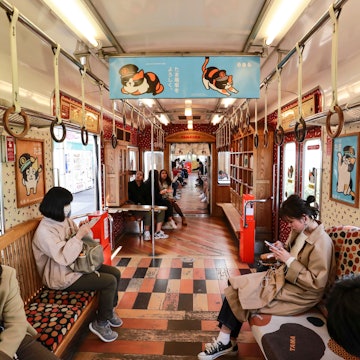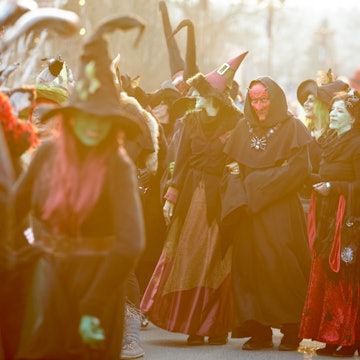

Tokyo is blessed with one of the world's most efficient public transportation systems. It's a city of 'paper drivers' - those who have licences but haven't touched a steering wheel in decades. And who can blame them? The city's trains are spotless, quiet and nearly always on time. Tokyo also has a network of buses and a flotilla of taxis, but most travellers find that the trains cover all their transportation needs. Here's what you need to know to make your travels as smooth as possible.
Competing rail lines
Tokyo's train network is so exceptionally thorough because multiple operators run competing lines. Japan Rail (JR) controls two of the most useful lines, the above ground Yamanote (loop) and Chūō (central) lines. The colour-coded tangle of subway lines - 13 in all - are run by one of two operators, Tokyo Metro or Toei. There are also a handful of private lines running like spokes out to the suburbs. What this means is that you may find yourself having to exit the ticket gates from one line and enter the gates for a different line when transferring - though it's a usually a seamless process thanks to plenty of English signage.
Buying tickets
At all stations, tickets are purchased from vending machines that accept coins and bills (but not credit cards). Fares are determined by how far you ride, so you'll need to select the appropriate fare for your destination when buying a ticket. These are usually noted on either a fare chart (bilingual) or a map above the ticket machines (often only in Japanese). If you can't work it out, one easy trick is to buy a ticket at the cheapest fare (¥130 for JR; ¥160 for Tokyo Metro; ¥170 for Toei) and use one of the 'fare adjustment' machines, near the exit gates, to settle the difference at the end of your journey.
Train passes
Few Tokyoites use paper tickets these days. Most just run their wallets - containing pass cards kitted out with electromagnetic chips - over the scanners at the ticket gates. If you're planning to be in Tokyo for more than a couple of days, it makes sense to get one if these - to reduce the headache of calculating fares and transferring between rail lines.
There are two different cards, Suica (available from JR ticket machines) and Pasmo (available from Tokyo Metro ticket machines), which are virtually interchangeable and can be used on all city rail and bus lines. Train station vending machines and also some convenience stores accept Suica and Pasmo as a form of payment - keep an eye out for card readers.
You need to pay a ¥500 refundable deposit to get the card, which you'll get back whenever you return it at one of the station windows. Both Suica and Pasmo can be charged at all but the oldest ticket machines in increments of ¥1000; look for either the Suica or Pasmo logo on the machine.
For short-term visitors who plan to pack in a lot of sights in one day, there are also unlimited-ride day passes. You'll need to get one that covers the rail lines you'll be using, and purchase it from one of the station windows on those lines.
Tokyo Metro 1-Day Open Ticket costs ¥710 (child ¥360) and covers Tokyo Metro subway lines.
Common 1-Day Ticket costs ¥1000 (child ¥500) and covers both Tokyo Metro and Toei subway lines.
Tokyo Combination Ticket costs ¥1580 (child ¥790) and covers JR trains in Tokyo, all subway lines and Toei buses.
Navigating the station
Stations in Tokyo are sign-posted in English; you'll find exits and transfer routes all well marked. All train stations in the city have automated ticket gates. Feed the ticket in the slot, but make sure to grab it when it pops up - you'll need the ticket for the exit gates. If you lose your ticket, tell the station attendant where you started your journey; they're supposed to charge you the full fare (from the first station on the line) if you don't have a ticket, but it's worth a try - sometimes you can get away with only paying (again) the fare from your starting point.
Pass cards will also need to be swiped both on the way in and on the way out; a digital screen on the machine will tell you how much money is left on the card. If your ticket or pass card doesn't cover your journey, look for the 'fare adjustment' machines around the exit gates. You can also use these to charge pass cards.
Most train stations have multiple exits and multiple ticket gates. Keep an eye out for the bilingual Japanese-English station maps, usually outside the ticket gates, that show which exits are closest to major area landmarks. Finding the right one for your destination can save you lots of time above ground (where maps are few and far between).
Timing your journey
Tokyo's train system shuts down between roughly midnight and 5am (the price you pay for having clean trains). On a Friday or Saturday night the dash for the last train can be epic, and the journey painfully cramped. Rush hour, too: those images you've seen of white-gloved station attendants nudging passengers in to allow for the train doors to close are oh-so-true. Time your journey between the hours of 10am and 5pm, however, and you'll find plenty of seats.
More train tips
During morning and evening rush hour, certain cars on express commuter trains are set aside for women only; they're marked by pink signs on the platform. Groping on crowded trains, while not rampant, does happen.
In most train cars, the seats in the corners are set aside for elderly, handicapped and pregnant passengers. Technically mobile phones need to be switched off around these seats - but you'll see lots of locals breaking this rule.
The Japanese are big fans of queuing and form neat lines on the platform where the train doors are expected to open. That said, once you're in, you need to be quick and agile if you want to score a seat.
Eating, loud conversation and talking on the phone on the train will earn you dirty looks. Texting and falling asleep on the shoulder of the stranger next to you are okay.
All train stations have toilets that are pretty clean, though they don't always have toilet paper, soap or hand dryers. Most have coin lockers, too.
Lost items are recovered at a remarkably high rate. If you lose something, report it at one of the Lost & Found windows (marked in English) or, if you can't find one, at any station windows. Most station attendants don't speak English, so if gesturing and diagramming fail you, have your hotel call the lost and found hotline number for the appropriate train operator.
Seasoned commuters make note of which train cars match up with the escalators at the stations where they plan to transfer or exit, and ride accordingly. Look for cheat sheets posted around the platform diagramming each station on the line.

















